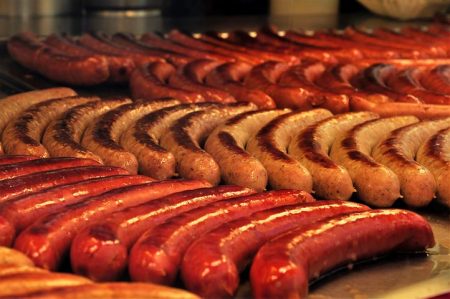 Using cutting-edge DNA-based technology, University of Guelph researchers have conducted the first-ever Canadian study of sausage mislabelling.
Using cutting-edge DNA-based technology, University of Guelph researchers have conducted the first-ever Canadian study of sausage mislabelling.
The researchers found mislabelling and cross-species contamination of meat ingredients in 20 per cent of sausage samples selected from grocery stores across the country.
“This study now provides us with a baseline that we can use when working with meat processors to help ensure we have a high quality and transparent food supply,” said Prof. Robert Hanner, who worked on the study with a team of researchers.
Published this week in Food Control, the study revealed that most mislabelling involved meat substitution. Some sausages labelled as beef also contained pork. Others labelled as chicken also contained turkey, and one pork sausage sample contained horsemeat.
The study, which was funded by the Canadian Food Inspection Agency, involved sausage packages labelled as containing only one type of meat.
The team of researchers used DNA barcoding along with digital PCR technology to determine which meats were in the sausage samples.

Developed at U of G, DNA barcoding allows scientists to identify species of organisms using a short standardized region of genetic material.
“There is DNA in nearly every cell of every organism, so barcoding can be applied to products such as ground meats that would be difficult to identify with other means,” said Hanner. “In this study, barcoding was used to identify the dominant meat type in the sausage samples.”
Scientists may use digital PCR technology to quantify DNA of a particular species. Tests developed at U of G for beef, pork, chicken and turkey allowed the researchers to measure proportions of these meats in the sausage samples. The researchers used another PCR test to detect horsemeat; this test indicated only the presence of horsemeat, not the quantity.
For beef, pork, chicken and turkey sausages, products were considered contaminated when more than one per cent of another meat was detected. This ruled out trace amounts that might have resulted from incomplete cleaning of processing equipment.
Findings revealed that five out of 15 sausage packages listed as turkey were entirely chicken.
Out of 27 beef sausage packages tested, seven samples also contained pork. Among 20 chicken sausage packages, four also contained turkey and one contained beef. Of 38 pork sausage packages tested, two contained beef and one, horsemeat.
Sausages labelled as single-meat but containing more than one meat type contravene food labelling regulations. Consumers may buy these products because of health issues, such as allergies, or lifestyle choices, such as avoiding pork, said Hanner.
Unknown contaminants may also allow transfer of food pathogens, he added.
“When there is a recall on a certain type of meat, we may miss it if it is present in a sausage product but not indicated on the label.”
Meat contamination could reflect human error or economic motivations, said Hanner, associate director of the Canadian Barcode of Life Network and a professor at the U of G-based Biodiversity Institute of Ontario.
“This study demonstrates that the technology is capable of monitoring the industry in a way we were never able to do before and is just one example of how DNA testing is becoming a standard for food ingredient authentication.”
Contact
Prof. Robert Hanner
Department of Integrative Biology
rhanner@uoguelph.ca
519-824-4120, Ext. 53479